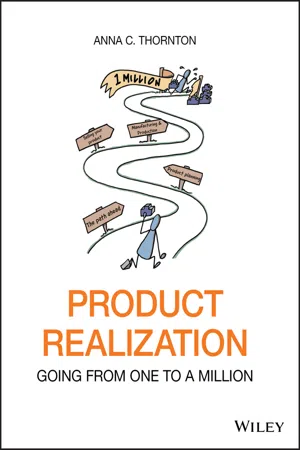
- English
- ePUB (mobile friendly)
- Available on iOS & Android
About this book
PRAISE FOR PRODUCT REALIZATION: GOING FROM ONE TO A MILLION
"A must-read reference for anyone who intends to successfully build a product and bring it to market."
?Desh Deshpande, Entrepreneur & Life Member of MIT Corporation
"This book is a go-to resource for new and experienced hardware teams to help them plan for and execute a new hardware startup successfully and avoid common pitfalls. Highly recommended."
?Bill Aulet, Managing Director, The Martin Trust Center for MIT Entrepreneurship & Professor of the Practice, MIT Sloan School and Author of Disciplined Entrepreneurship
"An excellent, practical guide for first time entrepreneurs building physical world products."
?Laila Partridge, Managing Director, STANLEY+Techstars Accelerator
"Product Realization picks up where so many product design books end. Here is the book that explains it all ? chock full of shop-floor wisdom, fascinating stories and compelling examples."
?Steven Eppinger, Professor of Management Science and Engineering Systems, Massachusetts Institute of Technology
"Product Realization contains the critical information and roadmap hardware entrepreneurs need as they take their concepts from prototype to production."
?Ken Rother, Managing Director eLab and Visiting Lecturer of Management, Johnson Graduate School of Management, Cornell University
Product Realization: Going from One to a Million delivers a comprehensive treatment of the entire product launch process from beginning to end. Drawing upon the author's extensive first-hand experience with dozens of successful product launches, the book explores the process of bringing a design from prototype to product. It illustrates the complicated and interdisciplinary process with vignettes and examples, provides checklists and templates to help teams, and points out common challenges teams will face.
Perfect for both students, start-ups, and engineers in the field, Product Realization: Going from One to a Million will be the go-to reference for engineers seeking practical advice and concrete strategies to launch higher quality products, at the right cost and on time.
Frequently asked questions
- Essential is ideal for learners and professionals who enjoy exploring a wide range of subjects. Access the Essential Library with 800,000+ trusted titles and best-sellers across business, personal growth, and the humanities. Includes unlimited reading time and Standard Read Aloud voice.
- Complete: Perfect for advanced learners and researchers needing full, unrestricted access. Unlock 1.4M+ books across hundreds of subjects, including academic and specialized titles. The Complete Plan also includes advanced features like Premium Read Aloud and Research Assistant.
Please note we cannot support devices running on iOS 13 and Android 7 or earlier. Learn more about using the app.
Information
Chapter 1
Introduction
- 1.1 Examples
- 1.2 Building Ten Thousand is Very Different from Building One
- 1.3 Product Realization is a Marathon
- 1.4 The Factory is Not a Giant 3D Printer
- 1.5 Three Rules
- 1.6 Why Learn about Product Realization?
- 1.7 Book Structure

1.1 Examples

- The Joint Strike Fighter (JSF) contract (now F‐35)1 award to Lockheed Martin was announced in 2001 with a plan for combat‐ready aircraft by 2010. The F‐35 has been significantly over budget and behind schedule. It is likely to cost over one trillion USD over the life of the program. As of the publication of this book, Lockheed Martin was still struggling with critical technical deficiencies as they got ready to increase production rates significantly [3].
- The Boeing 787 was plagued with delays due to documentation errors, supplier delays, assembly errors, supply chain issues, and battery quality issues. The initial cost was budgeted at $6 billion, but it has been estimated that the total cost was probably closer to $32 billion [4].
- GTAT's attempt to mass‐produce sapphire screens for Apple was plagued with production and yield issues. The yield issues were likely a contributor to the bankruptcy of the company in 2014 [5].

Table of contents
- Cover
- Table of Contents
- Product Realization
- Copyright
- dedication-page
- ACKNOWLEDGEMENTS
- Chapter 1: Introduction
- Chapter 2 Are You Ready to Start?
- Chapter 3: Product Realization Process
- Chapter 4: Project Management
- Chapter 5: Specifications
- Chapter 6: Product Definition
- Chapter 7: Pilot‐phase Quality Testing
- Chapter 8: Costs and Cash Flow
- Chapter 9: Manufacturing Systems
- Chapter 10: Design for Manufacturability and Design for X
- Chapter 11: Process Design
- Chapter 12: Tooling
- Chapter 13: Production Quality
- Chapter 14: Supply Chain
- Chapter 15: Production Planning
- Chapter 16: Distribution
- Chapter 17: Certification and Labeling
- Chapter 18: Customer Support
- Chapter 19: Mass Production
- GLOSSARY
- ACRONYMS
- REFERENCES
- Index
- Praise for Product Realization: Going from One to a Million
- End User License Agreement